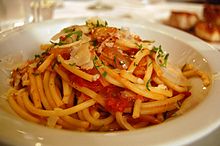Bucatini all'amatriciana
Bucatini all'amatriciana or Bucatini alla matriciana (in the Roman dialect ), also spaghetti all'amatriciana , are a traditional dish of Italian cuisine from Lazio . A sauce is made from guanciale ( bacon from the pork cheek ), tomatoes , pecorino , peperoncini (chilli peppers) and olive oil and served mixed with pasta . The dish can also be refined with onions and white wine.
In Amatrice , after which the Amatriciana is named, the Sagra degli Spaghetti all'amatriciana ("Folk Festival of Spaghetti all'amatriciana") is celebrated on the last weekend in August .
history
The original form of the pasta dish is the spaghetti alla gricia without tomatoes, which was widespread in the Abruzzo villages in the Trontotal , which at that time still belonged to the Kingdom of Naples . It consisted of the ingredients that the shepherds could take with them into the mountains because they were durable, like durum wheat noodles and bacon, or that they made themselves, like cheese.
The invention of the first tomato sauces (and then the possible introduction of the tomato in gricia) dates back to the late 18th century: the first mention of a pasta with tomato sauce appeared in 1790 in the cookbook L'Apicio Moderno , written by the Roman chef Francesco Leonardi . The recipe spread in Rome during the 19th and early 20th centuries due to the close contacts - even then for several centuries - between Rome and Amatrice. In Rome, Rione Ponte , an alley called Vicolo dei Matriciani (today Vicolo degli Amatriciani map ) and an inn with the same name have been documented since the 17th century.
In Rome, spaghetti was replaced by bucatini , thin hollow noodles. This version is the best known today. In the places of origin in the province of Rieti , however, the use of spaghetti is still insisted today.
On August 24, 2016, Amatrice suffered massive destruction from a strong earthquake two days before the Sagra degli Spaghetti all'amatriciana festival, with numerous dead and injured. In solidarity with the victims, over 700 restaurants in Italy and around the world took the pasta dish on their menu and agreed to donate two euros from the proceeds of each order to those who suffered the earthquake. This idea of the food blogger Paolo Campana spread via social media and was among other things. A. picked up by Jamie Oliver and Carlo Petrini .
Name variations
The original spaghetti alla gricia come, according to tradition, from the Abruzzo village of Grisciano, a district of Accumoli , from which they take their name. All'amatriciana , on the other hand, is derived from the nearby town of Amatrice . The version alla matriciana , which does not differ in pronunciation from all'amatriciana , was created by apheresis , which is typical of the Roman dialect .
Web links
- History of the Amatriciana (German)
- Florence Fabricant, The meat of the matter in a pasta debate , In: New York Times, January 16, 2008
Individual evidence
- ^ L'Arte della cucina in Italia , Emilio Faccioli, Einaudi, Milano, 1987
- ^ La cucina romana , Ada Boni, Edizioni di Preziosa, Roma, 1930
- ↑ Vie piazze e ville di Roma nel loro valore storico e topografico , Benedetto Blasi, Libreria di scienze e lettere, Roma, 1923
- ↑ n-tv news television: Donations from everywhere: eating spaghetti for Italy. Retrieved August 26, 2016 .
- ^ The Associated Press: Comfort Food: Eat All'amatriciana to Help Quake Victims . In: The New York Times . August 26, 2016, ISSN 0362-4331 ( nytimes.com [accessed August 26, 2016]).
- ↑ Dictionnaire romanesco , Fernando Ravaro, Newton Compton, Roma 2005
